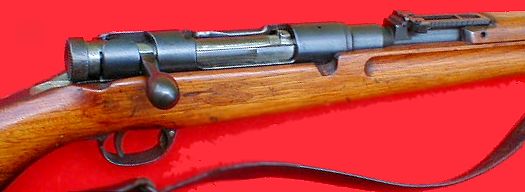

These rifles were issued to second-line troops to free up rifles in their main caliber from front line duties for the Franco-Thai War. Unlike the other Type 19 that is a copy of the Type 30 carbine, but in 7.92×57mm Mauser, this Type 19 is chambered in the Japanese 6.5x50sr cartridge.

Because the 6.5×50mmSR Arisaka cartridge it fired was considered underpowered, a replacement was devised, the Type 99 rifle, but both rifles saw usage until the end of the war. Even if you could find it, it would not be a bolt-on to the S&T. It has an under-folding bayonet similar to the Japanese Type 44. 6) Depress the floor plate catch located at the front inside of the trigger guard as shown in figure 6. In the late 1930's the Japanese developed a rifle to compete in 'Modern Warfare'. , After World War II, a lot of Type 38s and Type 44s were converted for use by China by switching to the 7.62x39 caliber since they were being equipped with AK and SKS rifles. The true military designation is unknown. Normal military wear to original used part with spots of pitting. Nariaki Arisaka, Superintendent of Tokyo Arsenal, and officially designated as the Type 38 (1905). It was developed under the supervision of Col. La marque S&T propose une réplique d'airsoft Spring de très haute qualité de l'ARISAKA Type 83 … Military and comercial. , Unlike the Siamese Type 66 (แบบ ๖๖), this rifle is a standard Japanese Type 38 in 6.5x50sr that was sent as aid from Japan to Thailand in 1940. Total production being about 38,000 rifles between summer 1940 and spring 1941, this rifle was found too cumbersome for too little benefit and was replaced by the Type 99 Short Rifle. The barrels were shortened to 635 mm (25.0 in) from the standard 794 mm (31.3 in) barrel and the stock shortened to match the barrel while the handguard retained its original length. WWII JAPANESE ARISAKA / TYPE 44 CLEANING ROD. The rifle was even longer when the 40 cm (15.75 inches) Type 30 bayonet was fixed. These rifles include: The Type 99 Long Rifle, the Type 99 Short Rifle, the Type 99 Carbine, the Type 99 Naval Special, the Type 100 Paratroop Rifle, and the Type … It is also not known if these were made before or right after the surrender of Japanese forces. A dust cover was added because of experiences in the Russo-Japanese War that left rifles inoperable from dust. Price $15.00 Japanese Arisaka Type 38 Rear Sight w/Pin.

The end result is a Type 38 which is similar in size to the Arisaka Type 99 short rifle. Blued finish with plain wood stock and leather sling. The design was adopted by the Imperial Japanese Army in 1905 (the 38th year of the Meiji period, hence "Type 38"). They all retained their original Japanese caliber of 6.5x50sr. , Two versions of the converted Type 38s consisted of rifles with just a SKS barrel. During the War, however, they were two of the most popular Japanese infantry weapons around.


 0 kommentar(er)
0 kommentar(er)
